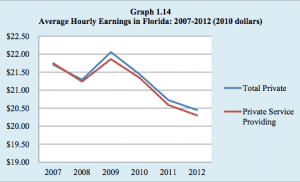The standard of living of Floridians has declined markedly since 2000, according to a just-released study by Florida International University.
Conducted by FIU’s Research Institute on Social and Economic Policy Center for Labor Research & Studies, the report entitled, 2013 State of Working Florida, focuses on four areas that affect living standards, namely: employment, income and inequality, cost of living and poverty. The report points out that the observed decline in the standard of living of Floridians has negatively impacted future economic growth and social mobility, as well as the pace of the current economic recovery.
Since 2000, Florida’s employment rate, median hourly wage and the average amount of hours worked declined by 4.99%, 4.34% and 3.11% respectively. At the same time, the poverty rate, inequality and consumer prices increased dramatically by 46.84%, 13.66% and 33.84% respectively, according to the report.
The study also notes that, Florida’s main employers – private sector service-providing industries such as retail trade, accommodation and food services, and administrative and waste management services are contributing to the decline in the standard of living due to an overall decrease in the wages and work hours offered. Despite increases in labor productivity, workers have not seen improvement in employment options or compensation.
More jobs and higher wages and better benefits are needed to correct these highly negative trends, the report recommends.
Here are some highlights of the report:
- In 2012, Florida had the second largest total number of workers with earnings at or below the federal minimum in the U.S., only behind Texas.
- Florida’s real household median income decreased $5,668, 11.51% between 2000 and 2011, a 1.03% annual decline, a faster and greater decline than observed nationally.
- In 2011, 22.60% of Floridians were in or near poverty, a total of 1,044,515 Floridians.
- In Florida, poverty increased by 46.84% between 2007 and 2011, an annual rate of 10.15%.
- Average annual salaries for the top six private sector employing industries declined by about 3.96% between 2000 and 2011. The top six employing industries employed 59.84% of all private sector workers in 2011.
- Between 2011 and 2012, wage inequality between the top 10% of wage earners and the bottom 10% grew by 8.37%, an annual difference of $4,638.40, the greatest increase of the past 12 years in Florida.
- In 2011, Florida’s Black/African-American families earned an annual income of $16,340 less than White non-Hispanic families, and Latino/Hispanic families earned $11,001 less than White non-Hispanic families.
- In 2011, Florida’s Black/African-American families were more than three times as likely to be poor than White non-Hispanic families. Latino/Hispanic families were more than twice as likely to be poor than White non-Hispanic families.
Read the full report HERE.



